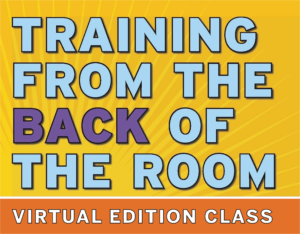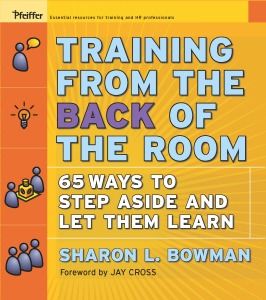8 Frequently Asked Questions about the TBR-VE™ Class
 I’ve been asked a number of questions by my blog readers and website commentators about the TBR-VE™ Class (TBR – Virtual Edition). So I’ve collected the most frequently asked questions – and my answers – and have posted them here.
I’ve been asked a number of questions by my blog readers and website commentators about the TBR-VE™ Class (TBR – Virtual Edition). So I’ve collected the most frequently asked questions – and my answers – and have posted them here.
Q. Does the TBR-VE™ Class take the place of the 2-day in-person TBR Practitioner Class?
A. No, both classes serve different purposes. While both classes cover the basic TBR concepts of brain-based, learner-centered training, the TBR-VE™ Class emphasizes virtual training strategies while the in-person class emphasizes strategies that work better in a face-to-face learning environment. The classes complement each other but they don’t necessarily cover all the same detailed content. Attending both classes will give you two different skills sets: one for virtual training and the other for in-person instruction. For more about the differences between the virtual and in-person TBR classes, click HERE.
Q: Will I be certified to teach the TBR-VE™ Class once I attend it?
A. No, it is not a certification class. The purpose of the class is to enhance your virtual training skills using some of the best concepts and strategies from “Training from the BACK of the Room” that are specifically for virtual learning environments. Of course, you can use what you learn from the TBR-VE™ Class in your own training programs; you just aren’t certified to present the class.
Q. How can I become a TBR-VE™ Certified Trainer?
A. To become certified to present the TBR-VE™ Class, you must first become a TBR Certified Trainer (licensed to present the 2-day in-person TBR Practitioner class) before you can obtain the TBR-VE™ certification.
To become a TBR Certified Trainer, you must attend an official 2-day in-person TBR Practitioner Class. Then you are eligible to attend the 1-day in-person Trainer Certification Course.
Once you become a TBR Certified Trainer, there are additional requirements for the TBR-VE™ certification – these include attending a TBR-VE™ Class as a participant.
 Q: Where do I find the list of current virtual and in-person TBR Classes being offered?
Q: Where do I find the list of current virtual and in-person TBR Classes being offered?
A: Click on my website’s Public Training Calendar and do check back as new classes are posted monthly. More in-person classes will be added as Covid restrictions decrease.
Regardless of which class you are thinking about attending – virtual or in-person – the best way you can improve your own teaching/training skills is to practice using the TBR concepts and strategies in your own classes and training programs. You’ll find a wealth of practical and useful TBR resources and ideas on my website. Click HERE and HERE for free infographics to get you started.
Q. Who will benefit from attending a TBR-VE™ Class?
A. The class is useful for anyone helping others to learn online, regardless of the topic, the age of the learners, or the complexity of content. While the class is geared primarily towards trainers, teachers, and instructors of adult learners, educators at both the primary and secondary levels can also benefit from the class. Many of the virtual strategies can be modified to appeal to a variety of student learning levels.
In other words, anyone who wants to move away from a traditional, slide-based, lecture-method mode of virtual instruction and towards a more learner-centered, collaborative, and interactive virtual learning environment will find in the class a treasure-trove of brain-based concepts and strategies that they can use right away in their own instructional design and delivery.
Q. As a TBR-VE™ Class participant, what will I need to know before the class begins and what will I get when I register?
A. The class structure consists of five 2.5 hour modules spaced over 2 – 3 weeks because brain research has shown this to be more beneficial for virtual learning than a 2-day remote information-dump.
Before the class begins, and in between each module, you will have about 2 hours of “Warm-Ups” and “Follow-Ups.” Brain scientists call these pre/post class activities “priming” and “spaced practice.” They are an essential part of virtual learning, and your success in the class – as well as the success of the other class members – will depend upon your commitment to complete these activities. Basically, this “homework” includes some reading, writing, viewing videos and/or slide presentations, and designing a short lesson or training plan by using what you’ve learned during the modules.
 Upon registering, you’ll receive a digital participant workbook to use for analog activities that go hand-in-hand with the digital strategies you’ll be experiencing. Again, brain research indicates that revisiting content at least six times and in six different ways (examples: writing, drawing, using body movements, talking, singing, typing, reading, manipulating digital objects, playing games, making up metaphors or stories, etc.) aid in long-term retention of important concepts.
Upon registering, you’ll receive a digital participant workbook to use for analog activities that go hand-in-hand with the digital strategies you’ll be experiencing. Again, brain research indicates that revisiting content at least six times and in six different ways (examples: writing, drawing, using body movements, talking, singing, typing, reading, manipulating digital objects, playing games, making up metaphors or stories, etc.) aid in long-term retention of important concepts.
You’ll also need to purchase (or the price may be part of the class fee) a digital or hard copy of the book “Training from the BACK of the Room” to use as a resource before, during, and after the class.
Upon completion of the class, you’ll receive a “TBR-VE™ Class Certificate of Completion” and an invitation to join the exclusive global community of TBR Practitioners on Slack.
Q. What does the TBR-VE™ Class cost?
A. Each TBR-VE™ Certified Trainer is an independent contractor and, as such, sets his/her own class fees. With that said, the average cost of the class is usually between $1097 – $1497, depending upon early-bird and other discounts that might be offered.
Q. Why wasn’t the TBR-VE™ Class offered earlier in 2020?
A. The original team of 12 TBR Certified Trainers who created the TBR-VE™ Class didn’t want to just dump a face-to-face training into a virtual one, like so many other companies were doing at the beginning of the global pandemic lockdowns. So they spent over 8 months researching, designing, and developing the best of virtual training concepts and strategies.
They experimented with the most advanced digital technology that enhances online collaboration, interaction, and community-building. They found ways to teach online that didn’t include slides and lecture-based instruction. They attended a “staging” class to learn the most effective ways of using live-streaming video and audio. In effect, they created what they hope will be the “Gold Standard” of virtual/remote training.
Even when the in-person TBR Practitioner Classes become available again, the TBR-VE™ Class will serve as an additional, complementary class to the in-person one – a class that emphasizes brain-based, virtual tools for trainers and teachers who are still instructing others in virtual/remote learning environments.
In Conclusion: I hope this information has been helpful and that you’ll consider attending a future TBR class, whether virtual or in-person. Please do let me know if you have other questions (email me at [email protected]).